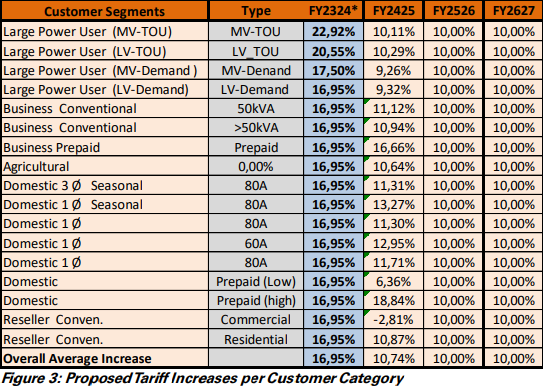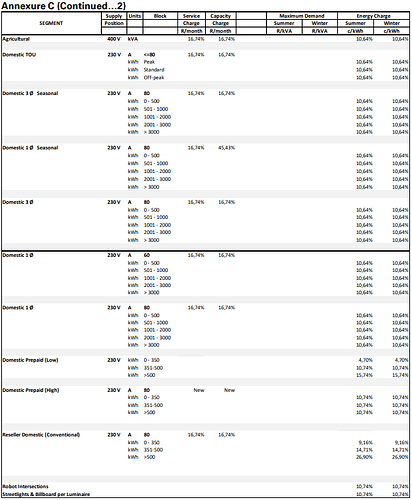I see the link in the article now has the draf rates published (It’s a zip):
https://joburg.org.za/documents_/Documents/2024-25%20PROPOSED%20TARIFFS.zip
Here’s the electricity doc:
ELECTRICITY SERVICES.pdf (473.2 KB)
Doing some quick scanning these stand out specifically relating to prepaid and/or PV:
- Subdivide the residual prepaid customers into two sub-categories namely
residential prepaid (low), to cater for the indigent customer and the residential
prepaid (high) to cater for the rest of the residential prepaid customers,- Residential prepaid (low) to be exempt from paying both the service and
capacity charges (R/month) to cushion our indigent customers in consideration
of the current economic climate. To ensure that tariff remains targeted at the
low use indigent customer it is proposed the block 3 tariff be increased above
the NERSA proposed average increase,- The residential prepaid (high) customer to start contributing to the service and
network operating and maintenance cost to gradually align to the tariff
applicable to the residential conventional tariff,
6 SUBDIVIDING THE RESIDENTIAL PREPAID INTO TWO CUSTOMER CATEGORIES
The tariffs that are applicable to the residential customer category are generally below cost of supply and are subsidised by other customer categories. As it will not be feasible to make the residential tariff fully cost reflective some element of cross subsidisation is necessary though to be limited to levels that are economically sustainable. While that is the case the price differential between the residential prepaid and residential conventional customer is still unjustifiable high. This was also confirmed by findings of the cost of supply study that residential prepaid tariff is to a greater degree below the cost of supply when compared to the residential conventional customers. The residential prepaid customer therefore does not adequately contribute to the network availability cost.
The residential prepaid tariff consists of energy charges only which can only be used when the customer consumes electricity. While customers may choose not to use electricity at any given time it is the kind of product that must be available on demand. The utility therefore must ensure that the distribution network is operated and maintained to ensure availability of supply on demand. Compared to residential conventional customer the prepaid customer contribution to network availability cost is still very inadequate and require substantial increase in the next three to five years to fully align to the conventional tariff.
However, at the same time shield the indigent customer against adverse tariff increase it is proposed to split the prepaid customer into two customer categories namely prepaid (low) and prepaid (high) and to subject the prepaid (high) subcategory to some element of service and network capacity charges for the financial year which will result in higher increases for the subcategory as outlined in figure 3 on page 9.
The scary part from the above (emphasis my own):
the prepaid customer contribution to network availability cost is still very inadequate and require substantial increase in the next three to five years to fully align to the conventional tariff.
And a snip of the proposed increases:

Note the 18.84% increase for Domestic Prepaid (high).
And the 6c network surchage for above 500kWh remains unchanged:
It is hereby proposed that the Network Surcharge remain unchanged at 6c/kWh. The Network Surcharge is based on energy consumed measured in kWh and is applicable to all customer categories. However, residential customers will be exempt for the first 500kWh per month, meaning that residential consumption beyond 500kWh per month will be subject to the Network Surcharge.
A snip of the full tariff annexure:
Worth noting the Domestic Prepaid (High) now has different blocks and also the service (R244.20 excl) and capacity (R237.30 excl) charges. It used to be 0-350, 350-500 & 500+, but now is 0-500, 500-1000, 1000-2000.
I actually think the 18.84% increase mentioned is either a typo / formula error or has some weird calculation for someone using 600kWh and includes the extra charges, because the increase % table clearly shows a 10.74% increase:
And then there is an Embedded Generator section. This is the flat rate for feeding back (excl) and has some t’s and c’s:

EMBEDDED GENERATOR MINIMUM CONDITIONS
1.1 In terms of the provision of the Electricity Regulation Act, (Act 4 of 2006) (ERA) generation of electricity is a licensed activity, unless exempted by the Minister of Energy.
1.2 This tariff will only apply to customers that are net consumers at City Power and who have invested in embedded generation capacity, are grid-tied (and comply with all the regulations regarding grid connection).
1.3 That the embedded generator is required to register with City Power and the equipment used must comply with the technical standards required by City Power.
1.4 All Large Power Users and Business Customers who would be willing to invest in embedded generation with the purpose of supplementing their electricity supply from City Power will have to be on a conventional tariff structure. If they are currently on a prepaid structure, they will be required to migrate to a conventional tariff structure.
1.5 All residential customers who would be willing to invest in embedded generation with the purpose of supplementing their electricity supply from City Power, will have to be on a time-of-use conventional tariff structure. If they are currently on a prepaid structure, they will be required to migrate to the time-of-use conventional tariff structure.
1.6 Embedded generators that are at any time capable of feeding energy back into the grid will require meters with bidirectional metering capability.
1.7 All parties that would invest in generating electricity capacity and who would elect to only feed into the grid (and never draw from the grid) will be treated as an additional supplier under a negotiated power purchase agreement.
1.8 Embedded generation tariff is only applicable to maximum generation capacity of 1MW.
Unlike Cape Town you do need to be a net consumer still (1.2), but also need to move to the Domestic TOU tariff (1.5).
Just to not have to scroll up to the full table here’s the TOU tariffs:

This includes the R244.20 excl Service Charge, but the Capacity Charge goes to R985.37 and then there’s a split between Peak, Standard and Off-peak consumption and a Summer / Winter split where most notably peak usage in summer is 270.49c/kWh (excl), but jumps to 622.31c/kWh (excl) in winter.
This is where the registering with City Power part gets murky for me as I really can’t tell if you can register, not feed back and stay on the prepaid tariff or if you have to go to TOU even if you don’t feed back and/or don’t want to get ‘rewarded’ for feeding back.

